Gorgeous ‘making of’ short for Hector Zamora‘s Errante — a large-scale urban hanging garden. The rest of his work is well worth some exploration too.
via The Pop-Up City
Gorgeous ‘making of’ short for Hector Zamora‘s Errante — a large-scale urban hanging garden. The rest of his work is well worth some exploration too.
via The Pop-Up City
Ailanthus altissima, a name that may not be in any way familiar, though there is a very good chance that a person who lives in the urban centers of Windsor or Detroit sees this “ancient” tree on a daily basis. This tree is known as “Tree of Heaven” or to some “Tree from Hell.”
The tree of heaven is a native to northeast China and Taiwan, it thrives in temperate climates and is capable of reaching heights of 15 meters in 25 years, though it has a relatively short lifespan of 50 years. What might be the significance of this tree you may ask. Well, it’s on the forefront of the cultural mythos of Detroit’s current revitalization.
This is not the first time that the Tree of Heaven has been reclaimed as an icon for cultural growth in circumstances and environments of neglected or “broken” urban centers. In 1943, Betty Smith wrote A Tree Grows in Brooklyn, which features the Tree of Heaven as its main metaphor for “the ability to thrive in a difficult environment.”
There’s a tree that grows in Brooklyn. Some people call it the Tree of Heaven. No matter where its seed falls, it makes a tree which struggles to reach the sky. It grows in boarded up lots and out of neglected rubbish heaps. It grows up out of cellar gratings. It is the only tree that grows out of cement. It grows lushly…survives without sun, water, and seemingly earth. It would be considered beautiful except that there are too many of it.
–A Tree Grows in Brooklyn, Introduction
Laura Paolini of Bell Payphone Labs arrived yesterday with a mission to bust open her payphones. We found all the tools and help we needed out on the street. Otherwise, business as usual down on Pelissier, with one week left to go!

Wednesday was a big day in the SRSI spaces. Lea Bucknell held her Garden Party in 424 unveiling the portraits and stories that she made of Windsor residents, ProClick Factory arrives from Toronto, Thom Provost and Josh Babcock work on some hand-drawn diagrams.
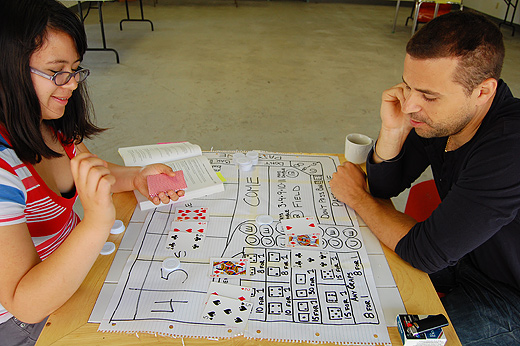
Josh Babcock starts working on his Invention Solution Hub, Robin Fitzsimons trains hard for her big trip to Caesar’s Windsor, Kids’ crafts are on display in 424 Pelissier, The Department of Unusual Certainties are holding consumer surveys, and Thom Provost talks to the community about his ideas.
Continue reading “SRSI, Day 18 & 19: Gambling, Crafts & Plans”
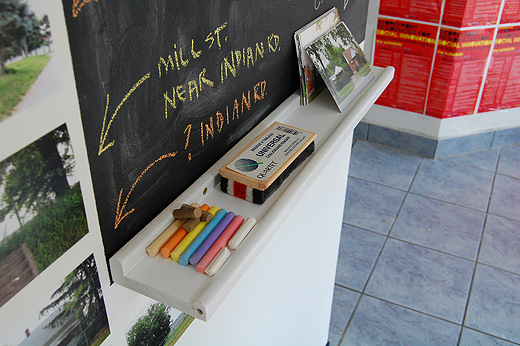
Leesa Bringas’ Postcards to Indian Road project is coming along nicely; some postcards with messages have been returned to her in the mail. Jodi is wrapping up her Sweater Factory with a few completed sweater vests and more to come. BCL Research Fellows Josh and Rosina have been helping the Department of Unusual Certainties with field research, and The Garden Project planters are filling up.
Continue reading “SRSI, Day 14: Field Research, Sweater Vests and Postcards”
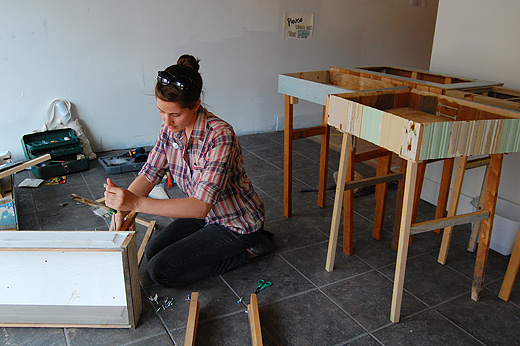
Lea Bucknell arrived from British Columbia to take over the window display of 424 Pelissier, Andrea Carvalho sent pictures of her last tactics in Windsor from Montreal, and SRSI participants get a surprise gift from a local fan.
Continue reading “SRSI, Day 12 &13: Tactics, Presents and Garden Party Plans”
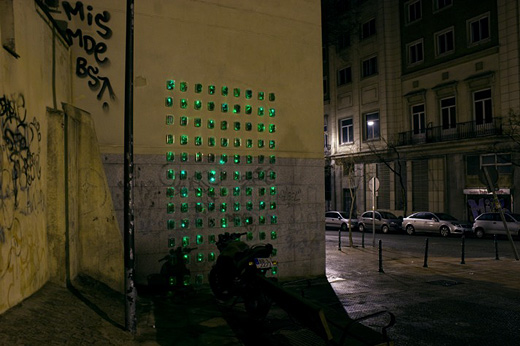
Luzinterruptus is a Madrid-based light art intervention collective. They’ve done some really large-scale works in streets around the world, this project, Garden for a not too distant future, being one of their most recent.
From their site, “For this installation we used 110 transparent food packaging containers, inside which we put leaves and branches found in the trees in the area and lights of course. Afterwards, we placed them on a wall in an ugly square in the center of Madrid and there we left our form of fashionable vertical garden.”
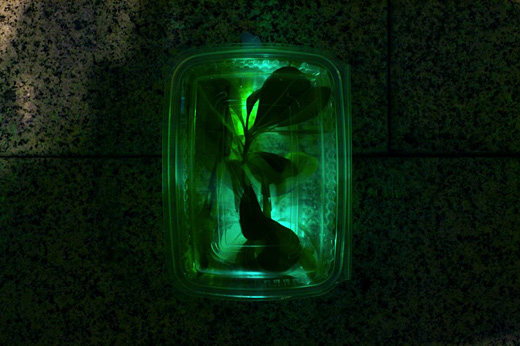
The work critiques the arguably impractical value of vertical gardens in public spaces, with the collective stating, “… if we continue to eradicate it from public spaces or reducing it to inaccessible vertical faces, the only form of contact with nature will be in supermarket refrigerators, packaged with expiry dates.”
I suppose what I find most interesting about their work is the relentless necessity to encounter it at night — and that they insist on working in the context of outdoor space. According to an interview on UrbanArtCore, they head out nearly once a week to create an installation; here’s hoping summer gives us that kind of time.
Photos by Gustavo Sanabria.
[via Designboom]
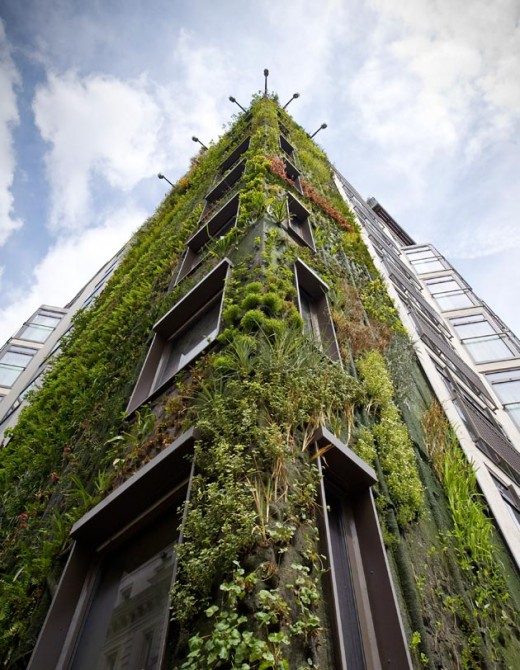
Projects such as this Vertical Garden seem to be easier and easier to find, which hopefully means that they are becoming realized more often and in more locations. This particular project is a vertical collection of plant life that Patrick Blanc recently completed on a corner of the Athenaeum Hotel in London, England.
According to the project summary located on the hotel’s website, “It’s a fairytale dream of a wall, erupting with trailing tendrils and flowers eight storeys high above Piccadilly’s red buses like a living tapestry. As well as hosting native plants and flowers, way down below beside our Garden Room there’s the world’s biggest collection of non-nettly-looking nettles – or Urticaccae… This humid microclimate is the perfect spot for the more exotic species.”
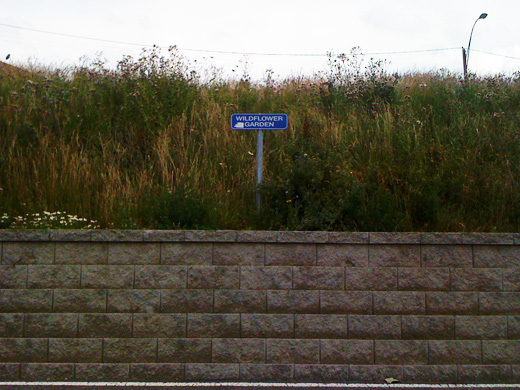
Another walk along the riverfront today, this time with Andrew and Barb from Render / DodoLab. Windsor’s meadows are looking incredible, and if this strike ends it’ll be quite disappointing to see so many patches of long grasses and wildflowers cut down.
I can understand that there was a point at which people could have thought that things looked “messy,” but I think we’re well past that now. Windsor is now into a full-on prairie meadow stage and it’s gorgeous.
So, this sign, and this area pictured above, is as the sign says, a Wildflower Garden. It’s official, it was made official by that simple blue sign on a galvanized pole. So, if all it takes is a sign, why don’t we make official some other prime Windsor meadow locations and reclaim some space for “naturalized areas.” I’m going to be on the look out for particularly great locations to formalize as Windsor’s naturalized meadows.
Or if signs aren’t your thing, but you still want to work with these amazingly wondrous meadows, head out with Leesa Bringas at 8am every morning for some grass braiding.